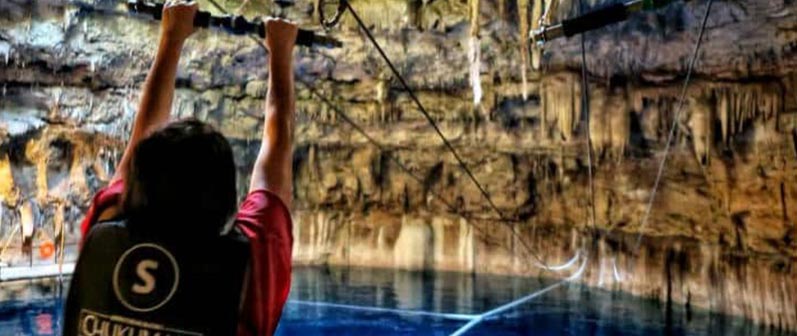Valladolid
The historic capital of the eastern Mayan
Listed by the government as one of the magical towns of Mexico, the city of Valladolid in Yucatan is a quiet corner, excellent to stop for a few days and explore this area of the Yucatan Peninsula.
There are tons of things to do in and around Valladolid, like swimming in cenotes and visiting some of the most famous archaeological sites in Mexico, including what is probably number one in popularity: El Chichén Itzá.
Recommended activity:
Hacienda Chukum
The underground cenote of the Hacienda Chukum park (more than 40 meters in diameter) has three natural openings in its roof that allow sunlight to illuminate its turquoise waters.
Thanks to its adaptation, this attraction offers several activities full of adrenaline for visitors.
Since the cenote is fully equipped with zip lines, three diving platforms built at different heights ranging from one to four meters above the water level.
In addition, Chukum-Ha has a rope swing and a rappel experience of more than 18 meters through one of the openings of the cavern into the water.
What to do in Valladolid?
Better known as “el zócalo”, as the main squares of each city are called in Mexico, visiting Plaza Francisco Cantón Rosado is one of the best things to do in Valladolid.
Before the arrival of the Spanish in 1543, a Mayan pyramid was located in this same place, which was demolished and with its stone they built the buildings that surrounded it. Two of those constructions are still standing: the San Servacio Church and the Municipal Palace, although with various repairs over the years.
The Zócalo of Valladolid, in Yucátan is an excellent place to sit in the particular chairs facing each other and watch the activity of the city while you enjoy eating a marquesita from the street stalls (crepe with different sweet fillings and cheese).
San Servacio Church
The Iglesia San Servacio is one of the main symbols of Valladolid, not only for its religious and architectural importance, but also for its history.
The current building dates from 1703, but that does not mean that previously there was no other church right there. It was there that two dismissed mayors took refuge from the persecution of the angry residents of Valladolid. Upon finding them, both were murdered inside the temple, which led the bishop of the moment to ask for their destruction. In its place, the current church was erected, changing the location of both the altar and the entrance, the only one in Yucatán facing north instead of east.
city Hall
If you have already been to other zócalos in Mexican cities, you will quickly recognize which is the Municipal Palace building.
With two floors and a gallery of arches on the ground floor, the Municipal Palace of Valladolid, current House of Culture, was built in the likeness of the Royal House of Santo Domingo, in the Dominican Republic.
Admission is free, and on the first floor there are murals representing the history of the city and great views of the square.
Be sure to take advantage of the free night walking tour, which leaves every night from the Municipal Palace.
Municipal market
I never miss the opportunity to take a tour of the markets in every city I visit. In the same place we can learn a lot about the culture, gastronomy and indigenous traditions, since markets like the municipal one of Valladolid are not entirely oriented to tourism but rather it is where local people shop.
Besides being a very good place if you want to take a typical souvenir with you, it is also like an amusement park for those of us who love to try authentic regional dishes. As you will see on your trip if you like to experiment, Mexican cuisine is much broader than what can generally be found in Mexican restaurants abroad, and the Yucatecan specialties are proof of this.
Some of the typical dishes of Valladolid and the Yucatan peninsula are tenderloins, oriental pickle, lime soup and, to toast, xtabentún liquor, made from anise and honey from bees fed with this flower.

